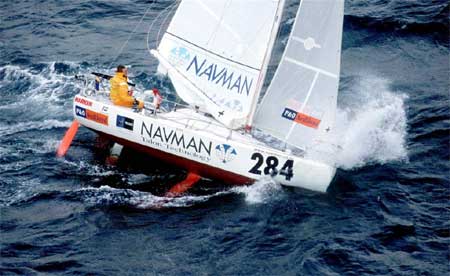|
Oceans Alone
by Rebecca Hayter
review by Paul Kenna
 Anyone
who purchases John
Welsford's book Backyard
Boatbuilder will see the bizzare high tech Mini Transat
boat in the pictures. Not exactly a plan available off the shelf
for such a specialised yacht with twin dagger boards in the bow,
twin rudder on the stern and keel that kants from side to side. Anyone
who purchases John
Welsford's book Backyard
Boatbuilder will see the bizzare high tech Mini Transat
boat in the pictures. Not exactly a plan available off the shelf
for such a specialised yacht with twin dagger boards in the bow,
twin rudder on the stern and keel that kants from side to side.
To anyone who does not follow short handed ocean
racing, or I suspect, anyone not living in New Zealand, Chris
Sayer would not be recognised. John's design and
Chris's determination made the 1997 Mini Transat 6.5m yacht Navman
competitive and innovative, allowing Chris to secure 3rd place
overall.
In a later challenge the French organisers and
government (remember Rainbow Warrior anyone?) did everything in
their power to prevent Chris competing in the 2003 event in 6.5m
yacht that was designed by another NZ designer but developed the
themes John had started in timber and ply in a kevlar and carbon
hull that weighed 85kg.
The book written by NZ journalist Rebecca Hayter
gives an insight into Sayer, Welsford and the NZ tenacity when
cornered or challenged.
Of particular interest is a passage about John
Welsford:
"But if John Welsford was surprised by
Chris's ambitions, many were
surprised by Chris' choice of designer."
"Bearded, quite spoken, Welsfords opinions
are firm and he fixes his listener with his unblinking gaze as
he talks. He describes himself as a
'woodworking machinery sales engineer and family man, who designed
small boats as a hobby'. He loved timber and enjoyed designing
traditional style boats: little yawls and nutshell sailing dinghies
for day sailing or the occasional night away camping."

The world of solo ocean racing is one of stark,
aggressive innovation, of expensive complex structures in Kevlar
and carbon fibre technology. To those that knew of Welsfords work
at the time - and few racing yatchmen did - he and the modern
species of offshore racing yachts were about 80 years apart.
"I went to John because he could think
outside the square" says Chris. "He's actually quite
a clever cookie. I've always liked simple boats so keeping it
simple was primary. In a way it was quite good being separated
from the French because they are not looking at what they are
doing and you come up with fresh ideas and I think we did that
quite well" "
I'd recommend the book to anyone who has been
bitten by any of John's designs.
Apart from being a great read about a nautical underdog, it gives
you insight into the designer of the boat that will be between
you and the wet stuff. |

